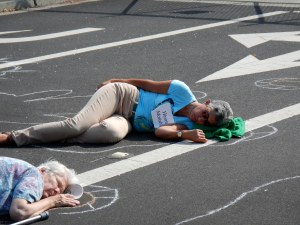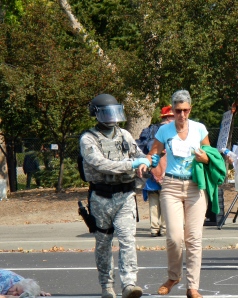If I had a choice, I wouldnt go to Livermore, California in August. Its crazy hot. And its scary dry.
But I dont go to Livermore for the weather.
I go because nuclear weapons are created, developed and tested at Lawrence Livermore National Laboratory. I go in August to commemorate the dropping of the first atomic bomb in Hiroshima, Japan on August 6, 1945.
I go to risk arrest because I cannot stay home and let the anniversary of this event go unmarked. Go unnoticed.
Though Robert Oppenheimer and his gang developed and tested the atomic bombs dropped in Japan in New Mexico, Livermore Lab continues the legacy.
Plus Livermore flourishes in my backyard. My hood. Staying away feels like Im permitting them to conduct business as usual in my backyard.
And so I go to Livermore. To step in. To say no. To use my body against the further creation, production and testing of nuclear weapons.
The Lab and I have a long history. Ive made this journey on this day and others, for more than 25 years, Sometimes wearing my Greenpeace campaigner hat, sometimes wearing my Western States Legal Foundation board member hat or my Agape Foundation executive director hat. This time, wearing my concerned citizen hat. Always with other nonviolent activists and people of faith, young and old, organized by Western States Legal Foundation, Tri-Valley CARES and other local anti-nuke organizations.
Under the baking mid-morning sun, I risk arrest lying on a hot black tar road at the entrance to the Labs West Gate. My body and my fellow protestors occupy the pavement.
The sun bears down on my back. On my arms. On my legs. I can feel sweat forming on my face. I dont wipe the beads away. The smell of hot road fills my nostrils. Flies land on my hands. I dont swat them away. I dont move. Im lying there, feigning death. In a mock die-in. To replicate the lives of those who fell on the streets of Hiroshima and Nagasaki on two August mornings when the US chose to unleash the unthinkable.
Fellow protestors outline our bodies in chalk on the pavement. Mimicking the effect of the Japanese people whose bodies, seared by the impact of the bomb, only left a shadow outline on the street.
A white piece of paper, proudly pinned to my chest, bears the name of Hiromu Morishita, a hibakusha, a survivor of the atomic bombing in Hiroshima. Mr. Morishita, president of the Senior High School Teachers Society and the Hiroshima Peace Education Institute in Japan, was one mile from the atomic bomb explosion, which severely scarred the left side of his face and blew off his ear.
I think about all the lives lost on that day. And about the lives of those lost most recently in the Middle East and in Eastern Europe. I dont distinguish between innocent lives and the lives of the not so innocent. Im saddened by my inability to stop those deaths or to stop these weapons.
Committed to nonviolence, I havent seen a war Ive liked or supported. They all end in bloodshed, trauma and destruction. They weigh heavy on our souls. Making us small and inhumane.
Eventually an Alameda County Sheriff approaches me, tells me if I leave I wont be arrested. If I stay I will be. I dont move. I cant. And still remain true to myself.
I rise from the ground when the officer tells me Im under arrest. Escorted by an officer in camouflaged riot gear, I walk past the phalanx of heavily uniformed police. The officer asks for my ID, then handcuffs my hands behind me. One hand holds my California drivers license.
A female officer pats me down, looking for weapons, sharp objects. The only item in my pocket, a pin of Greenpeaces ship, the Rainbow Warrior to remind me of one more reason why I am standing on the other side of the law.
Another officer helps me into a waiting van, already occupied by my fellow protestors. We introduce ourselves. Some I have known for decades. Others I meet for the first time. All friendly. All here for the same reason. The last person to join us, a nun in her 80s who attends religiously. We total 30.
The van drives a short distance; officers escort us out of the van into a warehouse, set up to handle the booking. Two women record the information on my license on two separate forms. I sign them both. I ink my thumbs for fingerprints. I receive a copy of my citation for blocking a roadway.
Since we are the last arrestees, the guards quickly escort us out the gate.
No officer asks us why we spent our morning remembering this day of horror for more than 200,000 Japanese people. But we all know why.
This wasnt my first trip nor will it be my last to the scene of this crime.




